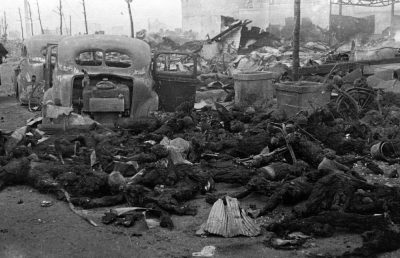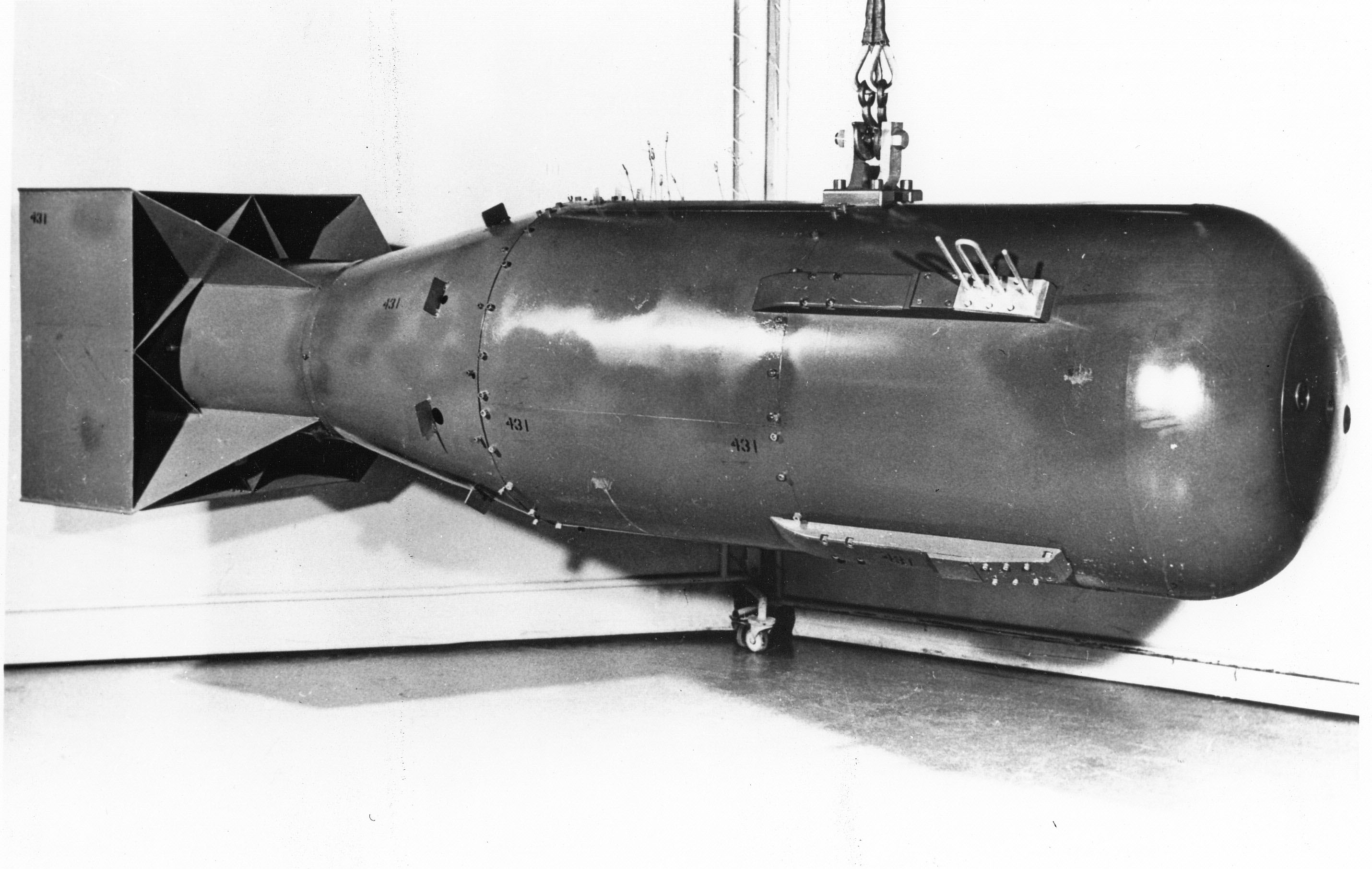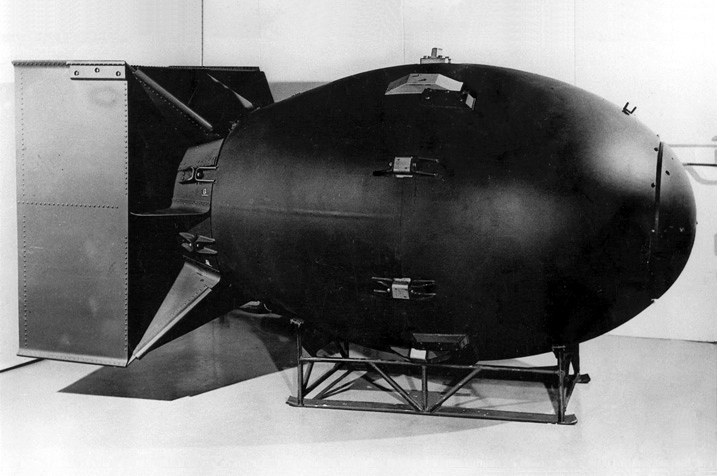World War II: US Military Destroyed 66 Japanese Cities Before Planning to Wipe Out the Same Number of Soviet Cities

Remember:
Hiroshima, August 6, 1945
Nagasaki, August 9, 1945
Timely historical analysis: This article was first published in June 2019
The extent of devastation inflicted upon Japan by the American military during World War II is not broadly known, even today. In reprisal for the attack over Pearl Harbor, which killed almost 2,500 Americans, US aircraft first began unloading bombs on Japan during the afternoon of 18 April 1942 – attacking the capital Tokyo, and also five other major cities, Yokohama, Osaka, Nagoya, Kobe and Yokosuka.
Participating in this opening incursion over Japanese territory, known as the “Doolittle Raid”, were a modest 16 US B-25 medium bombers which killed about 50 Japanese, while meting out minor overall damage. Yet the air strikes represented an embarrassment for Tokyo’s leaders, and they further dealt a sharp psychological blow on the Japanese mindset. To rub salt into wounds, not one of America’s B-25 aircraft was shot down. It was a sign of things to come.
As months elapsed into years, the destruction increased many times over. By 15 June 1945, 66 Japanese cities had been annihilated by the US Army Air Force, through firebombing attacks primarily unleashed by the new B-29 four-engine heavy bombers.
The number of Japanese metropolitan areas destroyed here was the exact figure that the Pentagon compiled when finalizing plans, in mid-September 1945, to eviscerate the Soviet Union. Indeed, 66 Soviet cities were earmarked to be wiped out – with 204 atomic bombs – less than two weeks after Japanese representatives signed surrender terms on 2 September 1945, finally closing out World War II.
Regarding atomic attack proposals against the Japanese Empire, General George Marshall, the US Army Chief of Staff, revealed in 1954 that,
“In the original plans for the invasion of Japan, we wanted nine atomic bombs for three attacks”.
Just prior to Hiroshima the Pentagon had less than half a dozen A-bombs, however.

Photograph of a mock-up of the Little Boy nuclear weapon dropped on Hiroshima, Japan, in August 1945. This was the first photograph of the Little Boy bomb casing to ever be released by the U.S. government (it was declassified in 1960). (Source: Public Domain)
The world’s first nuclear attack was unleashed at 8.15am local time in Hiroshima, on 6 August 1945, as a 15 kiloton bomb hurtled through the air when released from a B-29 aircraft. After falling for 44 seconds, the “Little Boy” atomic weapon detonated directly over Shima Hospital in Hiroshima’s city centre, instantly turning into ashes all of its doctors, nurses and patients. In the surrounding landscape, dozens of further hospitals, schools and historical buildings were razed to the ground.
Tens of thousands were killed immediately as ground temperatures momentarily soared from between 3,000 to 4,000 degrees Celsius. Of those people situated within two kilometres of the bomb detonation point, 112,000 would be dead within a year (10 August 1946).
Further thousands were also killed from radiation poisoning and severe burns, among those present in the hundreds of metres beyond the two kilometre radius mark. The majority of the dead and dying were civilians, men too old or sick to serve in the armed forces, along with large numbers of women and children.
Hiroshima’s vital arms and manufacturing complexes, scattered along the city’s periphery, were completely undamaged. These plants accounted for 74% of her total industrial output. Unscathed too was Hiroshima’s crucial port and military embarkation point on the Ota Delta. Almost 95% of Hiroshima’s factory workers were unhurt following the explosion.
On hearing of the atomic blast a few hours afterwards, president Harry Truman heralded it as “the greatest thing in history” and “an overwhelming success”.
Three days later, 9 August, Nagasaki was attacked at 11.02am local time with a more sophisticated 21 kiloton bomb – which was released over the city’s educational, cultural and religious heartland. As with Hiroshima, the Nagasaki bombing left unharmed most of the city’s war-making industries.

A mockup of the Fat Man nuclear device. (Source: Public Domain)
This “Fat Man” bomb killed further tens of thousands; including many hundreds of schoolchildren, along with destroying the city’s main hospitals, cathedrals, temples and schools. Medical facilities in both Hiroshima and Nagasaki were decimated, adding significantly to the death tolls.
Echoing Washington’s support for atomic assaults were the Western media, almost without exception. Of 595 newspaper editorials written regarding the nuclear explosions from early August until late December 1945, less than 2% opposed the attacks which would kill more than 200,000 people.
The press also firmly supported the firestorming of both German and Japanese cities, in actuality they had “demanded more bombing of civilian targets”, even criticizing air strikes over military and industrial zones. For example, New York’s Time magazine praised the annihilation of Tokyo, which left around 100,000 dead, as “a dream come true… properly kindled, Japanese cities will burn like autumn leaves”.
Elsewhere, although Japan’s hard-line militarists proposed fighting to the last man, their political leaders were compelled to announce surrender on 15 August 1945, when threatened with further atomic attacks. General Leslie Groves, directing America’s A-bomb project, informed General Marshall on 10 August 1945 that another Nagasaki-type plutonium weapon would be “on the target” and available for use “after 24 August 1945”.
The USSR’s declaration of war on Japan during the evening of 8 August 1945 also influenced Tokyo’s capitulation; with the Red Army, in the following days, cutting through Japan’s elite armies across Manchuria like a hot knife through butter. Another factor was the American guarantee, relayed on 11 August 1945, that Emperor Hirohito – a God-like entity in Japan – could continue in his role following the surrender, though he would have no real power.
Just after the first atomic attack Japan’s Chief Cabinet Secretary, Hisatsune Sakomizu, estimated that his country could hold out for another two months at most: to October 1945. Japan had long been beaten in the air, as too at sea, while her imports of crude oil, rubber and iron ore ceased to exist. Japanese forces were driven from Burma and throughout the Pacific territories.
In addition, according to high ranking figures like Admirals Chester Nimitz (Pacific Fleet Commander) and William Leahy (Truman’s Chief of Staff), the ongoing, crippling blockade of Japan by sea, coupled with conventional air attacks, would induce their surrender within weeks, making any US land invasion or atomic bombings unnecessary. The A-bombs were in reality dropped as a warning signal to the Soviet Union, America’s new and long-term enemy as highlighted by General Groves in March 1944.
Through non-nuclear bombing, the destruction of dozens of Japan’s metropolitan areas was overseen by Major General Curtis LeMay, who implemented increasingly murderous tactics. It should be remembered, however, that Japan’s army apparatus was particularly sadistic and brutal, committing atrocities predating World War II.
Yet it was Japanese civilians which bore the brunt of America’s military might. On 30 May 1945, LeMay openly boasted at a press conference that US air strikes had killed a million Japanese or more.
By the summer of 1945, over nine million of Japan’s citizens were left homeless, most fleeing to green areas. Just prior to the atomic explosions, 969 Japanese hospitals had also been destroyed by American airplanes.
Almost four years previously, Japan’s seemingly “unprovoked and dastardly attack” on the US naval base in Pearl Harbor, Hawaii – as president Franklin D. Roosevelt described it – was based on what were in fact well-grounded fears. For five months preceding Japan’s raid on 7 December 1941, Washington had been moving her B-17 heavy bombers in growing numbers to US bases in the Pacific, such as at Pearl Harbor, and also to Clark Air Base and Del Monte Airfield in the Philippines.
From mid-1941, half of America’s big bombers were shifted from the Atlantic domain towards eastern horizons, something that Japanese strategists were only too aware of.
The reasoning behind this military build up had been outlined in late 1940, by America’s famed pre-war planner and Air Force General, Claire Chennault, who outlined how the B-17s would “burn out the industrial heart of the Empire with fire-bomb attacks on the teeming bamboo ant heaps of Honshu and Kyushu”. President Roosevelt was “simply delighted” when hearing of this plan.
Notwithstanding Japan’s attack on Pearl Harbor, America would have shortly entered the war regardless – and in opposition to Tokyo – as both states by 1941 were already major rivals with incompatible ambitions in the great Asian and Pacific regions. On 15 November 1941, three weeks before Pearl Harbor, General Marshall told reporters in an “off-the-record briefing” that American aircraft would “set the paper cities of Japan on fire. There won’t be any hesitation about bombing civilians”.
A year before, on 19 December 1940, Roosevelt approved $25 million in military aid to China, Japan’s traditional nemesis, including the gift of aircraft. Twenty-five million dollars in 1940 equates to nearly half a billion dollars today. On 11 March 1941, America’s president signed into law the Lend-Lease Act, a program providing further materiel to the Chinese – and also to other nations like Britain, the Soviet Union and France, all of which were far from benevolent towards Imperial Japan.
For many months, Roosevelt had placed sanctions and an embargo on Japan, such as in response to Tokyo’s September 1940 occupation of Northern French Indochina, which harmed US interests in the vicinity.
On 26 July 1941 Roosevelt froze the entirety of Japanese assets in America, a drastic policy which amounted to a declaration of economic war on Japan, over four months before Pearl Harbor. Roosevelt’s action stripped Japan of a staggering 90% of its oil imports, along with eradicating 75% of her foreign trade.
Within days, the Japanese were forced to dip into their scant oil reserves, which on their current course would be used up by January 1943, unless her armies embarked upon further invasions.
In equal enemy numbers, there were few who could live with the ferocity of the Japanese soldier, who gained notoriety for his cruelty. Tokyo’s war planners turned their hungry gaze to yet more tantalizing conquests, lining up the resource-rich states of Burma, the Philippines, Malaya, Singapore and the Dutch East Indies (Indonesia), each of which would be conquered during the first half of 1942.
As the war advanced and tables slowly turned, the Western allies’ terror bombing of civilian areas – not only ranking as war crimes – also stood as a dismal failure in its bid to bring the conflict to swift conclusion. These morally bereft strategies, of which nobody was made accountable, actually prolonged World War II. The long-held idea that blood-drenched air raids would smash the people’s morale, forcing them to revolt against their leaders, was pure fantasy.
In the summer of 1945, Japanese civilians were more interested in laying their hands upon foodstuffs, with the nation gradually starving due to America’s naval blockade. What’s more, any attempt at rebellion would promptly be eliminated by Japan’s military police, the dreaded Kenpeitai.
Western leaders failed to discern the lessons of Germany’s early 1940s Blitz of Britain, which served to strengthen the British public’s morale, not weaken it. This reality soon became clear to Wehrmacht hierarchy; but not so it seems to leaders like Winston Churchill, who was advocating the senseless obliteration of medieval cities like Dresden as late as February 1945.
Targeting women and children with bombs left the German and Japanese war machines largely unmolested. The Nazis’ armaments minister, Albert Speer, was at times left dumbfounded by Allied air tactics over Germany, which often avoided the Reich’s industrial areas.
Across 1944 Speer, much to Hitler’s delight and amazement, actually oversaw an increase in both German aircraft and panzer production, which made possible such attacks as the Ardennes Offensive of December 1944.
The realities behind air bombing escaped the attention of others like LeMay, and his English counterpart Arthur “Bomber” Harris. After it was all over, Harris admitted in his memoirs that the stratagem underlying assaults over urban locations “proved to be wholly unsound”; and that the Allied leaders should have earlier directed their pilots more frequently towards bombardment of factories, communication signals and transportation lines, which would have finished off Nazi Germany and Imperial Japan before 1945.
While LeMay was speaking about the mass deaths of Japanese, which also destroyed more than 3.5 million homes, he did not mention that in mid-1945 much of Japan’s infrastructure still lay untouched; such as the country’s crucially important coal ferry between Hokkaido and Honshu while, incredibly, the rail network remained intact through to August 1945; as too did several industrial zones which LeMay’s B-29s roamed obliviously past.
*
Note to readers: please click the share buttons below. Forward this article to your email lists. Crosspost on your blog site, internet forums. etc.
Shane Quinn obtained an honors journalism degree. He is interested in writing primarily on foreign affairs, having been inspired by authors like Noam Chomsky. He is a frequent contributor to Global Research.
Featured image: Charred remains of Japanese civilians after the firebombing of Tokyo on the night of 9–10 March 1945.

